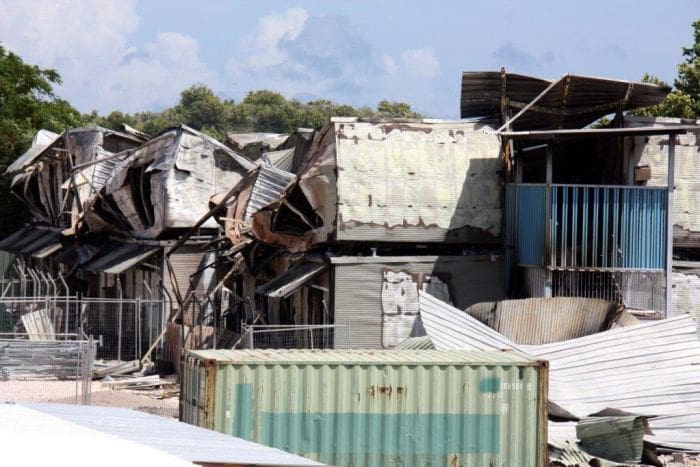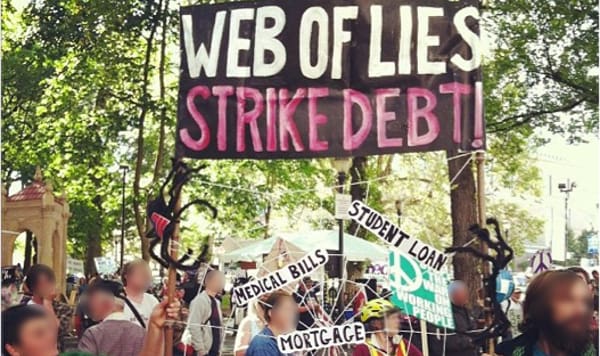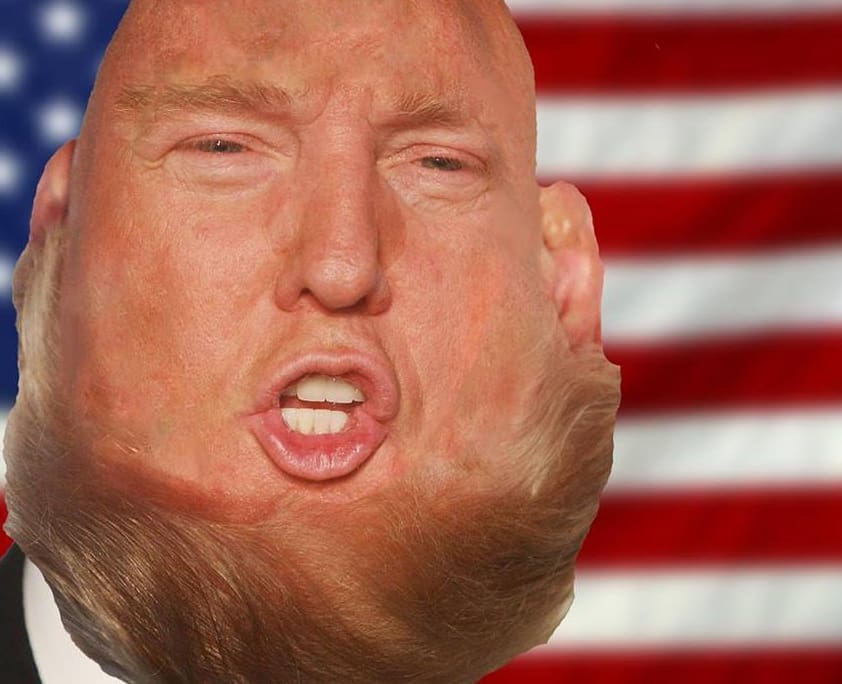Transcribed from the 30 June 2018 episode of This is Hell! Radio (Chicago) and printed with permission. Edited for space and readability. Listen to the whole interview:
In a capitalist system, you’re never really out of resources as long as you’re willing to host a prison.
Chuck Mertz: The future of Trump’s horrific immigration policy might be in Australia’s current, and even more horrific, immigration policy. Here to tell us what’s happening on the South Pacific island of Nauru and how what’s taking place there might be coming to the US really soon, political scientist Ed Burmila wrote the Baffler article “Out of Sight, Out of Our Minds: As the American detainee crisis deepens, Australia’s own immigration catastrophe points to a bleaker future.” Ed is an assistant professor of political science at Bradley University. He hosts the Mass for Shut-ins podcast, and writes frequently at Gin and Tacos.
Welcome to This is Hell!, Ed.
Ed Burmila: Hi, nice to be here.
CM: You write about Nauru, site of the Nauru regional processing center, which you describe as “a place for Australia to stash thousands of would-be immigrants and asylum-seekers they very much did not want on Australian soil.”
You start with a brief history of Nauru, writing, “The tiny Pacific island nation of Nauru, all 8.1 square miles of it, used to be a pile of shit; that is, a pile of very valuable phosphate-rich seabird guano. That explains why a tiny speck in the middle of nowhere was fought over and colonized by the Germans, then Australia and New Zealand (joint hall monitors of a League of Nations mandate), then the Japanese, and then the British. When it achieved independence in 1968, it was better positioned for the future than most European colonies in the Pacific, because the phosphate reserves were not yet depleted. More commonly, the UK would grant independence immediately after the last phosphates were mined (as in Kiribati in 1979), and some cynics have suggested that such timing was not entirely coincidental.”
Did Britain take all the wealth from Nauru and then grant Nauru independence?
EB: That was commonly what they did with their Pacific island colonies. You mine all the guano, and then when it’s gone you say, “Hey, by the way, we decided it’s time for you to get independence.” But what they’re doing right now—the arrangement that they have with Australia—is proof that in a capitalist system, you’re never really out of resources as long as you’re willing to host a prison. Australia is paying them quite handsomely to stash away some of their would-be asylum-seekers and immigrants. But if it weren’t Nauru, it would have been somewhere else: just go down the road and find the next poorest country, and eventually you’ll find someone who’s willing to open up an outdoor prison in exchange for however much money Australia is paying them.
CM: How dependent, then, is Nauru on holding thousands of would-be immigrants and asylum-seekers who are trying to get to Australia?
EB: Their second-biggest source of revenue beyond this is probably selling postage stamps to collectors online. It’s really a very tiny country. Unlike a lot of places in the Pacific, they can’t really pitch tourism. They’re too remote, too far from everything else, and they don’t have all the big luxury resort hotels and things like that. The whole island is eight square miles, and most of it looks like the surface of the moon from the century of mining. So they are really married to what they’ve become in this relationship with Australia. Other than this, they’re essentially dependent on foreign aid.
CM: How bad would things get for Nauru if the right thing happened—that is, the immigrants and asylum-seekers were given permanent residence somewhere other than Nauru?
EB: They would be in the same position that any other desperately poor country around the world would be in. They’d be reliant on international NGOs and nonprofits and things like that, because they really don’t have any ability to generate indigenous industry. They could maybe try developing their fishing industry a little bit more, but that’s about all that they could do, and that’s plenty competitive, so I think the future would be fairly bleak for them if they weren’t able to generate income this way.
CM: You write, “Legally, if migrants could be intercepted at sea and prevented from setting foot in Australia proper, the government could maintain legal cover for denying them a slew of rights and privileges.”
Is the Australian government, then engaged in a process to circumvent Australian law in order to deny rights to immigrants and asylum-seekers?
EB: As they see it, no. But they are certainly aggressive about intercepting people. They’re getting their immigration mostly by sea. People are getting to Indonesia, or Papua New Guinea, in whatever they can get to float: really unsafe boats. They will pile huge numbers of people in and try to reach the Australian mainland. They can legally request asylum once they set foot in Australia, so it’s sort of like back in the nineties when the United States had that “wet foot dry foot” policy. If you made it to part of the United States, then you could claim asylum, but if you somehow could be intercepted at sea then they could legally deny you that claim.
So Australia is putting a lot of effort into patrolling the northern part of the country’s territorial waters and making sure that they get at these convoys of migrants who are coming by water, before they can reach the northern part of the continent.
CM: You’ve written that “in exchange for detaining this most inconvenient population indefinitely, Nauru has received a steady and valuable influx of Australian dollars.” Indefinitely? Does Australia, Nauru, or anyone have any plans for these immigrants and asylum-seekers to ever live anywhere else?
EB: They do eventually get their applications for asylum processed (in very few cases, those applications are even approved). So they’re basically put in this gray area. It’s a holding pattern for however long it takes for Australia to process these applications. Most of them are denied and sent back to whatever country of origin they came from.
In a lot of cases, the migrants will then claim, reasonably, that they have compelling reasons not to go back to their country of origin, and then we really get into the gray. “Okay, we’re not letting you into Australia, you’re not going back to your country of origin or most recent origin or your country of citizenship, so what now?” They’re living in legal limbo. They are close to being stateless people. They are relinquishing their citizenship of the countries they’ve come from, but they’re not being accepted into Australia.
If we’re really going to commit to a zero tolerance policy, we’re going to be detaining a very large number of people very quickly.
The numbers add up quickly. Australia has been putting these people in detention centers or processing centers, and one of the points I try to make in the article is that in the United States, we’re getting vastly larger numbers of people. In Australia, if you add all their processing centers together, we’re talking about fewer than eight thousand people. The United States probably gets eight to ten thousand people a month, if not more than that, coming to the border to request asylum or to try to immigrate. If the white house’s policy is really going to be to detain all of these people and hold them in open-air tents or whatever, the conservative estimates are that by Labor Day we’re going to have thirty thousand children alone, and over a hundred thousand people who we’re going to need to put somewhere.
The reason that I went to Australia as a metaphor is that they have proven that if you’re really going to commit to a zero tolerance policy where you’re not going to let people in but you’re going to detain them, we’re going to be detaining a very large number of people very quickly.
CM: And apparently for a very long time. You point out that this detention center in Nauru opened up in 2001, shortly after the War on Terror began. What are the living conditions of the immigrants and asylum-seekers who are indefinitely detained, outside of Australian law, by the Australian government, on the small Pacific island of Nauru?
EB: It’s about what you would expect for people living in an open-air camp. These people have very little in the way of legal rights. I link a couple of international aid organizations in my article that have cited high levels of physical and sexual abuse going on in all of Australia’s processing centers. This is really a population that lives in the shadows. These are people who, because of their unclear legal status and their lack of resources to turn to, are very easy to exploit by people who would be interested in exploiting weak and desperate populations.
CM: You write, “The island was once again rich in resources, only this time the minerals were the poor, the abused, the war-ravaged, and the persecuted of Indonesia, Bangladesh, Afghanistan, Cambodia, and other troubled spots throughout Asia.”
Are the immigrants and asylum-seekers in some way—in any way—the outcome of Australian foreign policy? Are they fleeing wars supported by Australia or fueled by Australian arms? Or are they the victims of economic policies supported or enforced by Australia?
EB: It would be tough to blame Australia entirely, but there are certainly plenty of refugees coming from Afghanistan, and Australia (along with the United States and other countries) has been directly responsible for the deterioration of conditions there.
There are a lot of policies Australia has adopted throughout its history to try to limit specifically Asian immigration. Australian domestic politics are, in my opinion, the closest analog for American politics anywhere in the world. They’re very provincial. There’s more than a little bit of xenophobia. And they have been attempting throughout their history to restrict immigration from Asia by whatever means they could manage. They finally opened their borders a little bit in the late 1960s, but their immigration policies have been faced with a relatively large number of refugees because of countries in Southeast Asia that have dismal human rights records.
We can’t blame that directly on Australia, but countries like Myanmar, Thailand, Singapore, and the Philippines all have histories of treating minority populations within their own borders pretty poorly. The refugee stream certainly is due in part to the policies of countries like Australia and the United States, but domestic governments of countries in Southeast Asia have contributed to the problem as well by attempting to chase off various parts of their populations or engaging in discriminatory policies.
CM: On the history of Australia’s immigration policy, you write how they actually had a policy called “White Australia” that was the law of the land until 1973. Is Australia’s immigration policy and history—their record—even more racist than what we have here in the US?
EB: That’s a pretty dismal competition. It’s hard to say which one is worse. But Australian and American politics have some pretty strong similarities in the ways we’ve dealt with these issues. In 1973, Australia finally did away with the last vestiges of the “White Australia” policy, but they were really on the verge of becoming a second South Africa, an international pariah, and they changed the policy under the pressure of potentially going the way Apartheid South Africa did, when they were excluded from many international organizations and treated like a leper—of course they deserved to be treated that way for their policy, but Australia had a very liberal prime minister in the early 1970s named Gough Whitlam, and he was able to convince the country that they need to move forward or be permanently labeled a backwater and a regressive country. Eventually they started to open up the policy.
Immigration in Australia is a big issue, because they don’t have a very big population. Their argument in the 1970s, one of the reasons they had a lot of tension, was that the first wave of immigration into Australia was all Greek and Italian—and they are a small country. If you get a wave of two million people from Greece and Italy coming over to reside there, that’s going to significantly change the overall makeup of your population. To some extent you can see why people would be a little nervous about that. But at the same time, it’s an ample country, they have tons of resources, there’s no real reason they need to be worrying about overpopulating it.
CM: How much do the detention centers like the one on Nauru lead to any political debate? Is there cross-party support for that immigration policy, or is there a vibrant pro-immigration movement within Australia that is against what is taking place on Nauru?
Eventually the solution is going to be that it’s too expensive and complicated to hold these massive numbers of people, let’s just start putting them on planes and boats and pushing them back in whatever direction they came from and let them fend for themselves.
EB: Domestically they are very split over these kinds of policies. They have a couple of political figures—the most prominent of whom is a Trump-like figure, Pauline Hanson, who’s been on the scene since the nineties—who are sort of like Steve King from Iowa. They’re as far as you can go towards being a white nationalist without explicitly coming out and saying, “I’m a white nationalist.” Their whole political life depends upon bashing immigration and talking about white Australian culture and how it’s going to be changed by immigration.
There is a great deal of controversy over this issue, internally. There is a very pro-immigration “multicultural Australia” wing; there is that seriously nationalist, anti-immigration wing, and then, like in the United States, there are these people in the mushy center who are like, “Ugh, immigration gives me the willies, but I also don’t like the idea of these human rights abuses that we’re creating.” They really don’t know what to do with this.
CM: You were mentioning your concerns that this kind of policy might be incorporated into the Trump immigration policy. But aren’t Australian-style detention camps for immigrants and asylum-seekers already here in the United States? The group Freedom for Immigrants‘ new report, “Abuse Motivated by Hate and Bias in US Immigration Detention,” states that “Since January 20, 2017, when Donald Trump became the president of the United States, we have documented at least eight hundred complaints of abuse motivated by hate or bias in thirty-four immigration detention jails and prisons.”
Are Australian policies coming to the US, or are they already here?
EB: We are already holding large numbers of people in some sort of “detention,” in a legally unclear status. The point I was getting at with the piece was that if they really are going to stick to this “look how tough we are” zero tolerance thing, the number of people being held in that situation is going to exponentially increase. This is not new, we have been doing this for decades; like every country, we hold some people who aren’t citizens in an unclear status, whether we’re trying to deport them or deciding whether or not to admit them. But here we’re seeing it already, big tent cities on military bases in the middle of the desert. Back in the late nineties that was Australia’s idea: “Hey, why don’t we just put them all in the outback? It’s empty.”
I see some strong parallels of us going down the same path, because of these numbers—if they have two hundred thousand people by the end of 2018, that’s a very large population. Eventually we’re going to start asking questions: Is there somewhere we can put them where they won’t attract as much attention? That’s how Australia ended up with Christmas Island, and Nauru, and a couple thousand people they paid Papua New Guinea to take, and it really just became a mess.
I could see that happening in the US very easily and very quickly, because the numbers of people trying to get asylum and immigrate here are so large.
CM: How successful has Australia been at having this be a situation of “out of sight and out of mind”? For whatever reason, I have not seen any reporting on this here in the US media. I have seen some on Deutsche Welle, on France 24, on BBC, CNN International. I’ve seen reporting on it in the Guardian, the South Asia Times. But I haven’t seen anything about this in the United States. So how successful is Australia at keeping this situation out of sight and out of mind?
EB: We don’t get a lot of news about Australia, period. In the United States we’ve managed to avoid having to hear about it. Within Australia, it was a fairly successful policy at first. Domestically there has been a movement among Australian activists to draw attention to this, and over time it’s become a very prominent issue in their domestic politics. But if you make these people who are being detained harder to access, then it will be harder to report on, fewer people will hear about what’s going on, and eventually people might think less about it and move on to some other political issue, not worried about these detainees anymore. To that extent I think they have been successful. Keeping these people in very remote locations, in different countries or in isolated areas of their own country, has been pretty successful.
But since we’re fifteen-plus years into this policy, by now certainly it’s a common issue when Australia has an election or when activists are trying to draw attention to it. This is now well-known in Australia. But they started it in 2001, and it took a while for the attention to ramp up, because they’re essentially hiding people.
CM: You write, “The white house must be giddy with joy at the embarrassment of options available for a similar scheme in the United States. Which genius from the Cato Institute—or the Hoover Institute or maybe the American Enterprise Institute—will propose rebuilding the Puerto Rican economy by turning it into our very own legally-ambiguous floating prison?”
How good could immigration centers be for Puerto Rico’s economy?
EB: I don’t want to give them any ideas, but like I said, when the numbers of people who they are detaining under “zero tolerance” starts growing—one hundred thousand, two hundred thousand, a quarter of a million people is a very large number of people—they’ll see that they need to detain them somewhere, and eventually they’re going to start looking around for solutions that aren’t as easily accessible to anyone with a smartphone or major media organizations, and it would not surprise me if at some point, if they continue with this policy, that they start looking at options. Puerto Rico, middle-of-nowhere out in the West like Japanese internment during the Second World War—pick a spot in the middle of the desert somewhere. There is a limit to the number of people you can keep right on the border close to a large population.
CM: With the potential for mass immigration increasing due to climate change, what do these immigration policies portend? Do you see in the future a global system of out-of-sight, out-of-mind immigration and asylum-seeker detention centers?
EB: The European Union and the United States are both moving in a direction right now where they are simply going to start sending more people back to whatever their most recent point was. In Europe in particular there’s a great deal of trepidation in some countries about immigration from the Middle East and Turkey. In the United States we focus all of our panic and enmity on Mexico and Central America. Eventually the solution is going to be that it’s too expensive and complicated to hold these massive numbers of people, let’s just start putting them on planes and boats and pushing them back in whatever direction they came from and let them fend for themselves.
That’s most likely to be the outcome in the long term.
CM: On that happy note, I appreciate you being on our show. Thank you very much.
EB: Thank you.
Featured image: Some of the aftermath of riots at the Nauru migrant concentration camp in 2013. Read more about that here, at the news site we borrowed the image from. It got rowdy down there.






